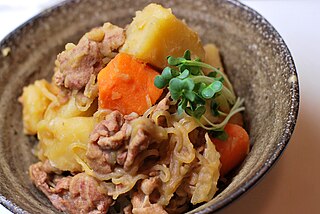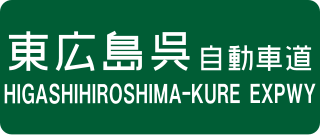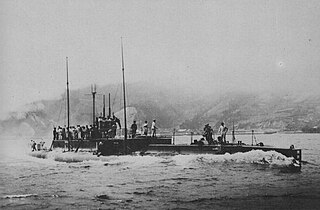
Yamato was the lead ship of her class of battleships built for the Imperial Japanese Navy (IJN) shortly before World War II. She and her sister ship, Musashi, were the heaviest and most powerfully armed battleships ever constructed, displacing nearly 72,000 tonnes at full load and armed with nine 46 cm (18.1 in) Type 94 main guns, which were the largest guns ever mounted on a warship.

Kure is a port and major shipbuilding city situated on the Seto Inland Sea in Hiroshima Prefecture, Japan. With a strong industrial and naval heritage, Kure hosts the second-oldest naval dockyard in Japan and remains an important base for the Japan Maritime Self-Defence Force (JMSDF) named, JMSDF Kure Naval Base. As of 1 May 2015, the city has an estimated population of 228,030 and a population density of 646 persons per km2. The total area is 352.80 km2.

The Japan Maritime Self-Defense Force, abbreviated JMSDF, also simply known as the Japanese Navy, is the maritime warfare branch of the Japan Self-Defense Forces, tasked with the naval defense of Japan. The JMSDF was formed following the dissolution of the Imperial Japanese Navy (IJN) after World War II. The JMSDF has a fleet of 154 ships, 346 aircraft and 50,800 personnel.

Nikujaga is a Japanese dish of meat, potatoes and onion stewed in sweetened soy sauce and mirin, sometimes with ito konnyaku and vegetables. Nikujaga is an example of yōshoku. Generally, potatoes make up the bulk of the dish, with meat mostly serving as a source of flavor. It is usually boiled until most of the liquid has been reduced. Thinly sliced beef is the most common meat used, although minced or ground beef is also popular. Pork is often used instead of beef in eastern Japan.

The Kure Line is a railway line operated by West Japan Railway Company within Hiroshima Prefecture in Japan. It begins at Mihara Station in Mihara and terminates at Kaitaichi Station in Kaita. It is one of the main lines of JR West. The section between Mihara Station to Hiro Station is branded the "Setouchi Sazanami Line" as the sightseeing line. On the section between Mihara Station and Hiro Station, most trains operate from Hiro Station through Mihara Station to Itozaki Station. On the section between Hiro Station and Kaitaichi Station, most trains operate from Hiro Station through Kaitaichi Station to Hiroshima Station or Iwakuni Station.
Kure Naval District was the second of four main administrative districts of the pre-war Imperial Japanese Navy. Its territory included the Inland Sea of Japan and the Pacific coasts of southern Honshū from Wakayama to Yamaguchi prefectures, eastern and northern Kyūshū and Shikoku.

National Route 31 is a national highway connecting Kaita, Hiroshima and Kure in Japan.

Kure Naval Arsenal was one of four principal naval shipyards owned and operated by the Imperial Japanese Navy.

Etajima base in Etajima city, Hiroshima prefecture is in the Etajima-cho government building and is the base of the Japan Maritime Self-Defense Force. Beside housing the 1st Technical School and the Officer Candidates School, it is home to the local Kure Naval District, LCAC training facilities, and Self-Defense Force oil storage. In addition, the Special Forces of the Maritime Self Defense Force is here.

The attacks on Kure and the Inland Sea by United States and British naval aircraft in late July 1945 sank most of the surviving large warships of the Imperial Japanese Navy (IJN). The United States Third Fleet's attacks on Kure Naval Arsenal and nearby ports on 24, 25, and 28 July sank an aircraft carrier, three battleships, five cruisers, and several smaller warships. During the same period the British Pacific Fleet attacked other targets in the Inland Sea region and sank two escort ships and several smaller vessels as well as damaging an escort carrier.

The Japanese city of Kure, Hiroshima was attacked repeatedly by Allied aircraft during World War II. These raids targeted the major naval base located at the city, ships moored at this base or nearby, industrial facilities, and the city's urban area itself.

I-55, later renumbered I-155, was an Imperial Japanese Navy Kaidai-class cruiser submarine of the KD3A sub-class commissioned in 1927. Early in World War II, she supported Japanese forces in the invasion of Malaya and the Dutch East Indies campaign before assuming training duties in Japan, interrupted briefly in 1943 by her participation in the Aleutian Islands campaign. She became a kaiten manned suicide attack torpedo carrier in 1945 before surrendering at the end of the war. She was scuttled in 1946.

I-54, later I-154, was an Imperial Japanese Navy Kaidai-class cruiser submarine of the KD3A sub-class commissioned in 1927. During World War II, she condcuted three war patrols, supporting Japanese forces during the invasion of Malaya in December 1941 and the Dutch East Indies campaign in early 1942, then was assigned to training duties until she was decommissioned in 1944. She was scuttled in 1946.

I-53, later I-153, later I-153, was an Imperial Japanese Navy Kaidai-class cruiser submarine of the KD3A sub-class commissioned in 1927. During World War II, she supported Japanese forces during the invasion of British Malaya in December 1941 and the Dutch East Indies campaign in early 1942. She served as a training submarine until she was hulked in January 1944. She surrendered to the Allies at the end of the war in 1945. She was either scuttled in 1946 or scrapped in 1948.

I-56, later I-156, was an Imperial Japanese Navy Kaidai-class cruiser submarine of the KD3B sub-class commissioned in 1929. During World War II, she supported Japanese forces during the invasion of Malaya in December 1941, the Dutch East Indies campaign in early 1942, and the Battle of Midway in June 1942. Except for brief service in the Aleutian Islands campaign in 1943, she subsequently served on training duties until selected for use as a kaiten manned suicide torpedo carrier in 1945. She surrendered to the Allies in 1945 after the end of the war and was scuttled in 1946.

I-57, later I-157, was an Imperial Japanese Navy Kaidai-class cruiser submarine commissioned in 1929. During World War II, she supported Japanese forces during the invasion of Malaya in December 1941, the Dutch East Indies campaign in early 1942, and the Battle of Midway in June 1942. She then served on training duties — except for a brief period of participation in the Aleutian Islands campaign in 1943 — until she was converted into a kaiten manned suicide attack torpedo carrier in 1945. She surrendered to the Allies at the end of the war in 1945 and was scuttled in 1946.

The Higashihiroshima-Kure Expressway is an national expressway in the southern part of Hiroshima Prefecture. The route connects the city of Higashihiroshima and the San'yō Expressway to the city of Kure on the coast of the Seto Inland Sea. It is owned and operated primarily by the Ministry of Land, Infrastructure, Transport and Tourism (MLIT). The route is signed E75 under MLIT's "2016 Proposal for Realization of Expressway Numbering."
Ro-26, originally named Submarine No. 45, was an Imperial Japanese Navy Kaichū-Type submarine, the lead unit of the Kaichū IV subclass. She was in commission from 1923 to 1938 and from 1939 to 1940.
Ro-28, originally named Submarine No. 46, was an Imperial Japanese Navy Kaichū-Type submarine of the Kaichū IV subclass. She was in commission from 1923 to 1938 and from 1939 to 1940.

Ro-11, originally named Submarine No. 19, was an Imperial Japanese Navy Kaichū-Type submarine of the Kaichū I subclass. She and her sister ship Ro-12 were the first submarines built to a fully Japanese design. She was commissioned in 1919 and operated in the waters of Japan. She was stricken in 1932.














